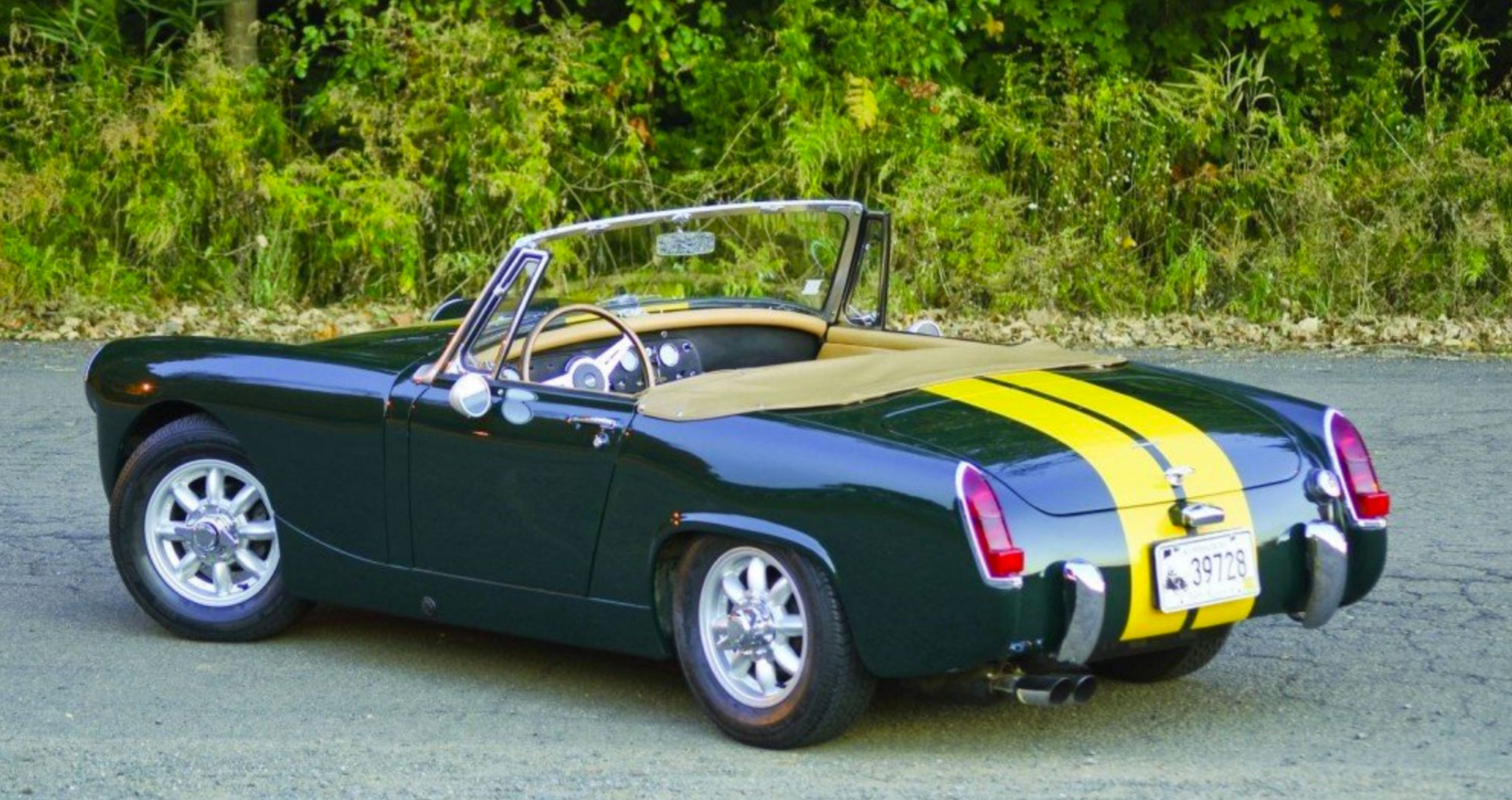The 1965 Austin-Healey Sprite Mark III received a host of new features, including locking exterior door handles, wind-up glass side windows, and a revised rear suspension for improved ride comfort. Minor engine tuning resulted in a power boost of 59 horsepower and 65 pound-feet, while the block casting and main bearings were strengthened to handle the increased output.
With its beautifully tailored upholstery, luxurious carpeting, and meticulous attention to detail, the interior would have eaten into the market for high-end cars like the Vanden Plas Princess, while the car's performance, aided by its heated-up A-series four, would have intruded on "Big" Healey territory. Today's fans, on the other hand, are unconcerned about such things. In fact, they're encouraged by the spirit of Donald Healey, who designed the Sprite to be a fun, affordable car that could be customized to suit the needs of owners of modest means, particularly those who wanted to go faster.
The Evolutionary Start Of The 1965 Austin-Healey Sprite Mark III Dates Back To The '50s
According to Silodrome, Austin and Healey were part of a larger conglomerate of British automakers called the British Motor Corporation in the late 1950s. BMC was essentially the British equivalent of the Volkswagen Group of today. Many BMC cars, like VW, shared designs.
Austin and Healey had previously worked together on a few other projects, according to Automobile Magazine. The 100-4 and 100-6 were small two-seat roadsters. Healey also produced larger vehicles, but they were more expensive. Austin and Healey desired something small and affordable that would be popular in both Europe and the United States. To save money, the new sports car would borrow from the Austin parts bin.
Thus, the Austin-Healey MkI Sprite, also known as the 'Bugeye' or 'Frogeye,' made its debut in 1959. The name is derived from the prominent headlights, according to Automobile. The designers were unable to use retractable headlights due to the previously mentioned cost savings. Instead, the Austin-Healey Sprite's headlights had been repaired and protruded from the clamshell hood. Aside from the cost, there was another advantage: it's impossible not to smile when you see a Sprite.
The rest of the vehicle was similarly sparse. There was no trunk on the MkI Austin-Healey Sprite, only a storage compartment behind the seats. There were no carpets, no radio, and no handles on the outside doors. There was, however, a convertible top and side windows made of plastic.
The Various Model Generations Of The 1965 Austin-Healey Sprite Mark III Remarkably Pulls A Stunning Performance
The original 1959 Austin-Healey MkI Sprite had drum brakes all around, independent front suspension, and a live rear axle. However, even by modern standards, the car's steering and handling are very good, according to Automobile. The Sprite did evolve over time. Three Austin-Healey MkI Sprites were entered into the 1959 12 Hours of Sebring as a publicity stunt. They finished 1-2-3 in their class. Later, a fixed-roof Sebring Sprite with more power and upgraded front discs would be available. Silodrome reports that one of these finished in 12th spot overall in the 1965 24 Hours of Le Mans.
Donna Mae Mims' track car of choice was a 1959 Austin-Healey MkI Sprite, according to RM Sotheby's. She modified it and raced it to become the first female SCCA champion in 1963. That Sprite, dubbed 'Think Pink' after its paint job, continued to race for another 25 years in the hands of two different drivers. Austin-Healey Sprites are still raced at places like Goodwood thanks to passionate fans and plentiful aftermarket parts—again, like the Miata.
The MG Midget and the Sprite MkII were released in 1961, with new headlights, bumpers, a stiffer body, and an actual trunk. In 1962, the engine was upgraded to a 56-hp 1.1-liter, and the Sprite received front disc brakes and a more powerful transmission. The Austin-Healey Sprite MkIII debuted in 1964, with a 59-hp engine and 65 lb-ft of torque. Wind-up glass windows and external door handles were also added to the roadster.
The MKIV, the final version, arrived in 1966. The 1.3-liter four-cylinder engine in this Austin-Healey Sprite was tuned to produce 65 horsepower and 72 pound-feet of torque. The brakes have also been improved. After the Austin-Healey partnership ended in 1971, the Sprite name was no longer used. Only the MG Midget was produced from then until 1980.
An Inexpensive Car That Ticks All Dependability
Many Sprites were simply driven into the ground over the years because they were designed to be inexpensive, cheerful sports cars. Rust is a major issue, as it is with all cars from this era, as are poor budget repairs that can make a project Sprite unsafe to drive without major work. Many Sprites were raced at the time, and they are still raced today.
Try a 1965 Austin-Healey Mark III if you're looking for a cheap Sprite. According to Hemmings report at Gateway Classic Cars, a perfect 1965 Austin-Healey Sprite Mark III costs $19,000 today. Lower grades, on the other hand, would be cheaper.


.jpg)
.jpg)
-1.jpg)